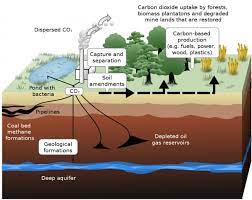Capture also refers to removing carbon dioxide directly from the atmosphere, called Carbon Dioxide Removal (CDR), or Direct Air Capture (DAC).
However, the flue gas coming out of a smokestack from the chimney of a power plant or industrial facility carries a much heftier amount of carbon, at around 10 to 15 percent carbon dioxide. Meanwhile, the concentration of carbon dioxide in the general atmosphere is around 400 to 450 ppm (parts per million), or about 0.04 percent.
“In the atmosphere, we have carbon dioxide that we’re worried about that’s significant from the point of view of affecting the radiative forcing and climate warming. But it’s very dilute from the point of view of capture,” says Harry Atwater, professor of applied physics and materials science at California Institute of Technology. “So people have to develop ingenious methods for capturing and then concentrating the carbon dioxide as a pure stream.”
The Swiss company Climeworks, for example, is one of the leading companies in the carbon capture space. Across Europe, there are more than a dozen direct air capture facilities that use fan-like machines to filter out carbon dioxide from the air and then heat up the captured molecules to pump them underground.
Another company, like Carbon Engineering, mist a basic chemical like potassium hydroxide to bind and draw down the carbon dioxide (which is acidic) from the air.
“There are multiple technologies for doing direct air capture that are being pursued. There’s also capture of carbon dioxide from the oceans,” says Atwater, like the ARPA-E project he’s working on which received funding from the Department of Energy.
Several National Academies reports indicate that technologies that actively remove carbon dioxide from the atmosphere need to be seriously considered as one of the many climate change combating solutions.
From Kelemen’s perspective, storage and sequestration are “pretty much synonymous,” except sequestration is used when the storage of the carbon dioxide is “essentially permanent” through methods like geological storage. The Norwegian Sleipner Project in the North Sea, for example, stores dense carbon dioxide fluid under pressure in a pore space under the seabed, Kelemen says.
Carbon sequestration underground has one major flaw, however—the major market for the technology is in enhanced recovery of fossil fuel, Atwater notes, where companies want to pump pressurized carbon dioxide into existing oil and gas reservoirs to get more product out.
Source : https://www.popsci.com/technology/carbon-capture-storage-tech/







